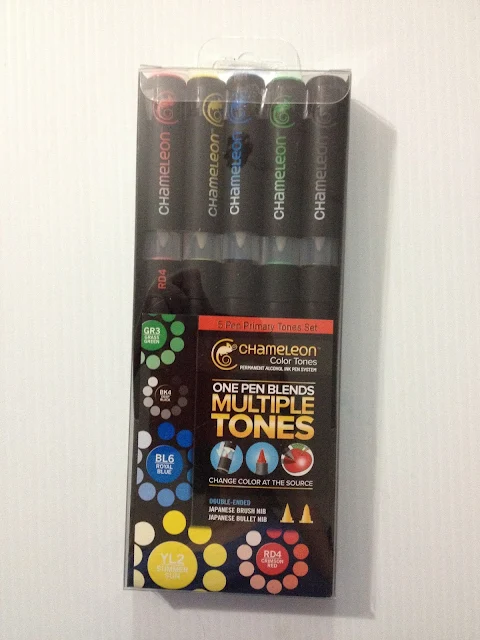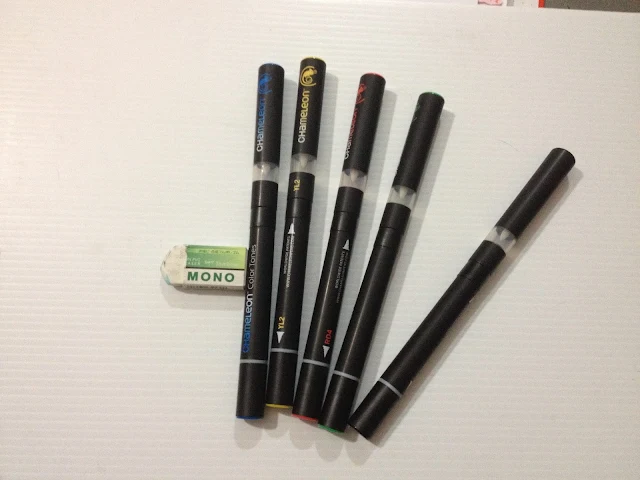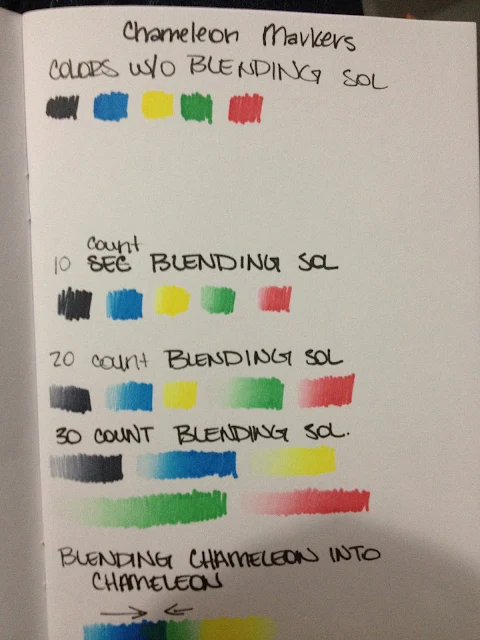Alcohol Based Marker Review: Chameleon Markers
It's been two years since I first started doing alcohol based marker comparisons, and these are some of my most popular posts. If you enjoyed this post, please consider checking out my other art supply reviews in my Reviews tab above. If you would like to purchase a set of Chameleon markers for yourself or a friend, please consider supporting this blog financially by using my Amazon affiliate search link for Chameleon markers.
As this blog is completely unsponsored, and I recieve no financial compensation from companies to write these reviews, nor do I recieve donations, I really depend on the goodwill of my readers. If you benefitted from this post, please consider contacting Copic or Chameleon with a link to this post and your thoughts. I would also sincerely appreciate it if you sent me an email with your thoughts, questions, or thanks.
If you enjoyed this review, please consider donating! Donations go
towards the purchase of additional art supplies, which may include more markers
for testing. If you found this review useful, please consider sharing it on your
social networks-sharing it on your social networks- a larger audience means I
can afford to do things like Kickstart future projects and makes me more
attractive to possible publishers. There's also a handy pocket edition of ALL
my marker reviews in a beautiful little 4"x6" photobook. It's available for $3
in my Nattoshop, and proceeds go towards things like keeping the
lights on and buying more markers to review.
I'd hoped that my days of testing alcohol based markers were mostly over, and that I could progress towards testing and reviewing the myriad of other fantastic art and illustration supplies that are available on the marker. The alcohol based marker reviews had a great run, they're some of my most popular posts, but lets face it, alcohol based markers are expensive to review.
Speaking of expensive, this basic pack of Chameleon Markers set me back around $22, and you can get your own from MarkerPop (where I got mine) for $21.59 That's about $4 a marker, which is cheaper than most Copics you'll find, but still more expensive than Prismacolor markers. Marker Pop does offer some colors as open stock at $4.79 a marker.
While Chameleon does offer a blender marker, my set didn't come with one. Instead, the gimmick is that every marker has it's own blender marker in the cap, called a 'charging chamber', and you have no access to that nib. If your colorless blender runs out, you can refill it using Chameleon's system, which includes a bottle of colorless blender and a syringe so you can inject it into the charging chamber's nib. This is pretty much how you refill any of the colors in Chameleon's color family- you purchase the individual, full strength ink and syringe set, and inject the color. You can buy the full 22 color set on Marker Pop for $84.99.
In theory, it makes sense. You have one 'master color' for each of the color families, and you use the charging chamber to get lighter tones of that color. Unfortunately, getting mixed tones, or applying shade, is where things really get complicated, because you need to rely on charging your color just right. If you're an illustrator, this degree of uncertainty, and need for careful counting, can be frustrating, especially when there are existing marker systems in place that allow you to work with more flexibility. If you're looking to save money, and think Copics are too expensive, there are plenty of great marker alternatives, like Prismacolors or Shin Han Twin Touches.
But I'm getting a little ahead of myself! First off, I really recommend you guys check out the Chameleon site, and get a feel for what Chameleon marker pens are all about. There's an informational (and promotional) video, so make sure your speakers are on or your headphones are in. From there, you can access their general menu, which offers a shop, links to tutorials, and more. You can even apply to become one of their artists and push Chameleon pens onto the public, all they want in return are 3 submissions and a year of your life. In return you get the 22 pen set, an $85 value!
You guys might want to finish reading this review before you sign yourselves up for this sweet deal though.
The Packaging
I don't really have high expectations for my marker packaging, since I cobbled together a horizontal storage system from The Container Store drawers. Honestly, the cheaper the packaging, the better, because I'm going to toss it if I like the markers.
However, I'm not just reviewing these markers for my own collection, but for yours. And I know many of you are either just starting a collection, or looking to augment a small, existing collection. And I know many of you don't yet have a storage solution for your markers yet, so if your markers come with a nice, sturdy case, that's a big bonus. And if they don't come with a case, they should at least fit into your existing marker storage solution, right?
Chameleon markers don't come with a particularly sturdy case, and they definitely wont fit into your existing marker storage system. These markers are freakishly huge, entirely due to the 'charging chamber' that comes attached to each marker.
If you have a smartphone with a QR reader, go ahead and check out this code. I assume it just leads to their website, which I've already linked, but maybe there's an easter egg I'm missing.
The set I bought comes with 5 markers and two additional Japanese nibs.
The Mono eraser isn't part of this review, other than as a stop to keep these markers from rolling all over the place. There is nothing on these markers to stop them from rolling all over the place- caps roll, markers roll, charging chamber rolls, and pretty much none of the caps post. You'd better keep a close eye on your markers and their accessories, because they'll just roll outta sight.
Given how small the Chameleon color family is, I'm not really sure they bothered to give them color family names. In this instance, it's almost as arbitrary as naming them "Fire Engine Red" and "Canary Yellow".
Initial Thoughts
It's a little difficult to photograph the interior of the charging chamber, but it has a nib (not sure what sort of nib, honestly) and a chamber full of colorless blender.
Although the alcohol isn't as strong as say, the Chartpak AdPro markers, Chameleon markers definitely do have an alcohol smell to them. As with any alcohol based marker, you should work in a well ventilated area.
As I was making my swatches, I noticed more and more that the blending chamber is unwieldy, and it would be difficult to work fast if you're juggling all these pieces. Most of us are used to keeping track of two pieces tops- a cap and the pen itself, but Chameleon markers add the blending chamber to the mix. Unfortunately ALL of these pieces are very prone to rolling, so you really have to keep track of everything.
The more I tested these markers, the more I was sure that these markers are probably not intended for illustrators, to be honest.
I did most of my swatching with the bullet nib, so I was pretty eager to get a look at the larger brush nib. The "Japanese brush nib" is different from any other brush nib I've ever seen, save for the Letraset flex markers, which are ALSO from the UK. Maybe this is a UK thing? These brushes aren't 'brush' shaped in the way Copic Super Brush nibs are brush shaped, but are more pyramidal and a bit soft. The Japanese brush nib is pretty small, not much bigger than the bullet nib.
My primary color set doesn't come with a blender, so how are you supposed to blend two totally different tones? I'm also having trouble finding these markers openstock, so if you're looking to only buy the colors you need or use, you may be out of luck. My set also didn't come with the promised instructions, so I had to google around for it. I ended up figuring out how to use these pens by reading Craft Test Dummies post on Chameleon markers, here. It did come with an additional set of Japanese nibs, but no tweezers. If you're just starting out, how are you supposed to have any idea on how to use these things? I feel like these markers would take a LOT of trial and error to get used to using.
Would make more sense to me if you were infusing color into a blank nib, rather than infusing blender solution into a nib full of color.
During Testing
Even for testing purposes, these pens are seriously unweidy- I almost need three hands just to charge the pens for the swatch tests. I can't imagine trying to use these for illustrations of any real size.
Neither cap posts to anything, and these markers are SUPER prone to rolling around, so I can imagine with all the confusion of juggling so many it'd be very easy to lose your cap. The bullet nib cap is really hard to grip and remove one handed.
The bullet nib pretty unremarkable, and there's a cap that separates the bullet nib from the charging chamber. Good luck not losing that one. Also, when the blending chamber is removed, these are some of the smallest markers I own, save for the Tria markers. As you can see, the blending chamber is almost as big as the marker itself.
In order to get a gradient of any significant size, you have to hold the blending chamber on for a really long time. Different colors require different lengths of time to achieve gradients of similar length. Some of the gradients are really streaky.
If you're going to buy Chameleon markers, I highly recommend making a blending chart with every color you own, for your future reference.
These markers pretty much function the exact opposite of any other alcohol based marker in terms of execution and color application. Rather than blending out your color, you blend your color in. For many, this may require too much re-thinking of traditional marker techniques
Blending Chameleon into Chameleon
It is pretty hard to blend these markers into one another without the use of a blender marker. By the time you've infused your second marker, your first has already dried on the paper. For these preliminary tests, I'm using cheap Multi Media paper (an Art Alternatives sample sketchbook), so the paper may be too absorbent to really allow for much blending.
Using Copic To Blend
So let's say you've bought a basic 5 color set, the set that doesn't come with a blender. I bet you're wondering if you can use other blenders to blend out your colors. In general, I find Copic's Colorless Blender to almost be a universal solvent (save for Chartpak Ad Pro markers), so I figured it would be a good blender to start with.
It reacts a little, but not much. I guess they're somewhat compatible, but you can't really use Copic markers to extend your limited Chameleon options.
Side By Side Comparison with Copic Ciao
The Breakdown
Chameleon Markers
20 Different Colors
$4.79 open stock at MarkerPop and on the Chameleon Site
2 nibs- Brush pen and Bullet Nib
Refillable
Replaceable nibs
Blender marker is available (it's $4.99 on the Chameleon site)
"Detail pen" available for linework (need to test if this is Multiliner and Micron compatible)
Availability: Available on MarkerPop, through Chameleon
Blendable
Japanese brush nib
Rolls all over the place
Color coded cap
Color Family and Name on Cap
Available somewhat individually, as well as in 5 and 20 color sets
Copic Sketch
Refillable
Replacable Nibs
Comfortable in hand
358 available number of colors
Blend-able
Color Name and Family on Cap
Color Coded cap
Super Brush
Can mix own colors, blank markers available
Availability: limited availability at Michaels, many art supply stores, Dick Blick, Jerry's Artarama, Jetpens, Amazon
Available in individual and color themed sets
Alcohol based
React to rubbing alcohol and 'blender' fluid
Can be blended
The Verdict:
If you really REALLY care about smooth gradients in a single color, and have a lot of time to spend holding the infusion chamber onto a marker and then hurriedly applying your color to the paper before the ink bleeds back into the nib, these are the markers you've been waiting for! I thought that by purchasing a set of the primaries, I'd at least have enough colors for a decent test, but without a blender included, that doesn't seem to be the case.
I think the concept is an interesting departure from the traditional alcohol based marker+blender system, but I don't think it's a successful departure, and I don't think including what is essentially a mini colorless blender with every single marker is the way to go. If you're looking to make your alcohol based marker collection REALLY stretch, and want to avoid buying the same color in every shade and tone, introducing wax or plastic paper palettes into your arsenal isn't a bad way to make one color stretch into many tones. If you REALLY wanted, you could even emulate these markers with your existing set by simply holding your blender marker on top of the color you want to make a gradient with. This method may ruin your blender nibs with darker colors, but you'll achieve the same effect that the Chameleon markers achieve.
Honestly, I'm just really not impressed with these markers, and I don't think they're a good fit for most illustrators who want to be able to render realistically. I think there are better, cheaper alternatives out there that are certainly more accessible. Let's face it, nobody is going to invest in a whole new pen system just for 'seamless blends' of a single color. That's a huge reduction in how color theory applies, and it's a little insulting to think that this is 'good enough' for illustrators.
If you're still interested in these markers, I can point you to a few other resources to check out
There are plenty of interesting tutorials on the Chameleon site, but I've yet to find one that explains how to use the markers if you're just getting started. I assume these tutorials work for any alcohol based markers. If you're more into video tutorials, there're quite a few online. There's this video from Craft Test Dummies for Chameleon markers, and this product review by Sandy Allnock.























Comments
Post a Comment